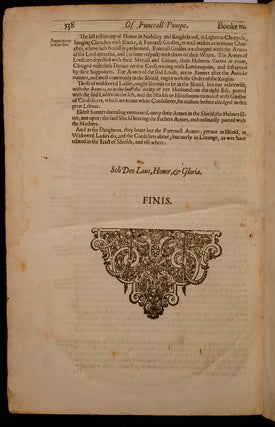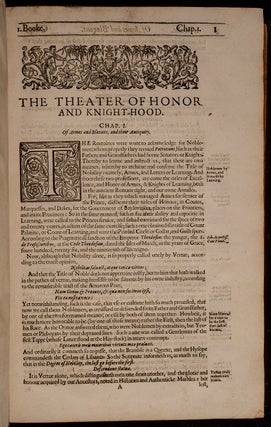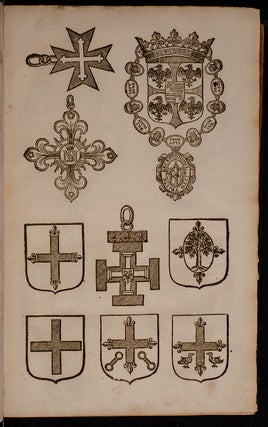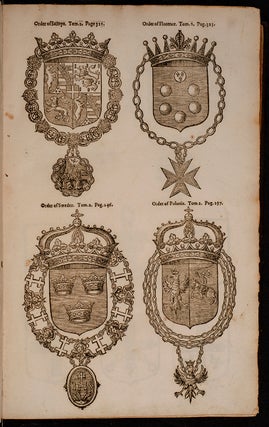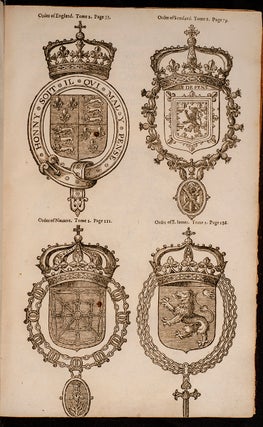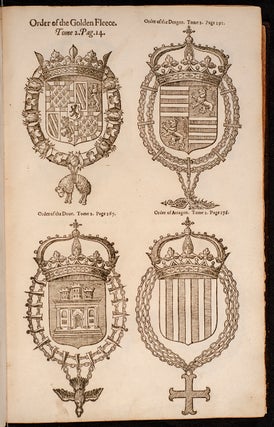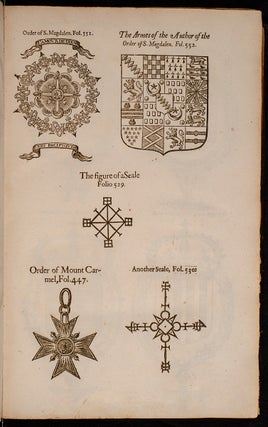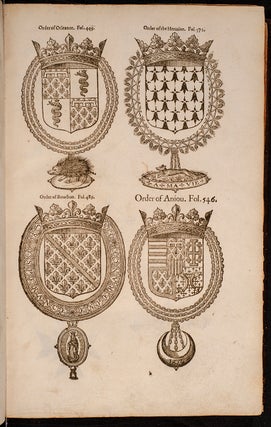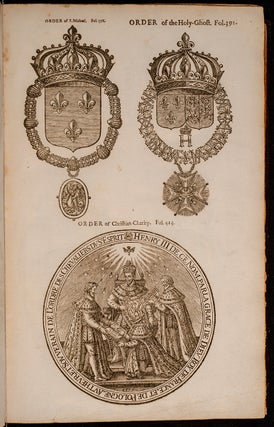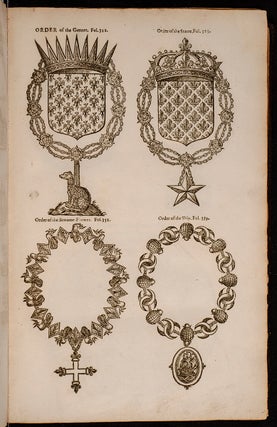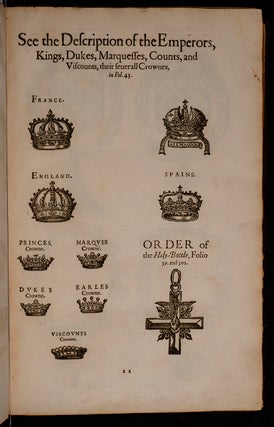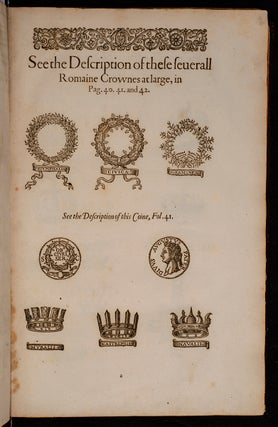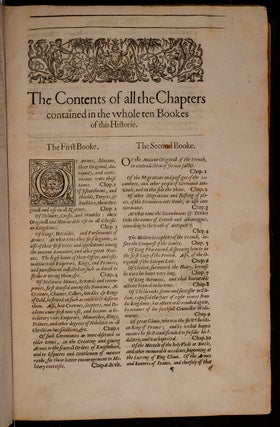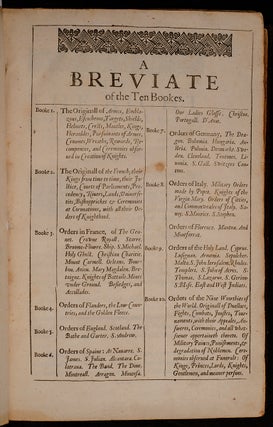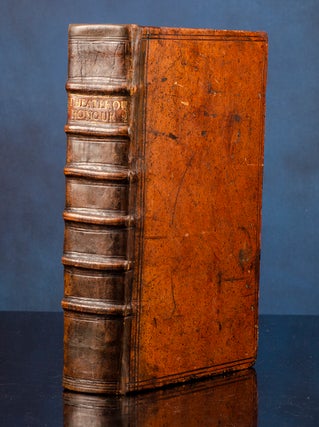The Theater of Honour and Knight-hood
London: Printed by William Jaggard, 1623. Item #05243
The Knights Templar in the Time of Shakespeare
Published in the Same Year and by the Same Printer as Shakespeare’s First Folio
FAVINE, Andrew. The Theater of Honour and Knight-hood. Or A Compendious Chronicle and Historie of the whole Christian World. Containing the Originall of all Monarchies, Kingdomes, and Estates, with their Emperours, Kings, Princes, and Governours; Their Beginnings, Continuance, and Successions, to this present Time. The First Institution of Armes, Emblazons, Kings, Heralds, and Pursuiuants of Armes: With all the Ancient and Moderne Military Orders of Knight-Hood in Every Kingdome. Of Duelloes or Single Combates, with their Originall, Lawes, and Observations…London: Printed by William Jaggard, 1623.
First edition in English. Folio in sixes (12 7/8 x 8 1/4 inches; 327 x 208 mm). Two volumes in one. [9], [12] leaves; 572 (i.e. 582); 406, [18], 407-538 pp. Complete with all twelve leaves of plates (rectos only) showing medals, coins and heraldic seals. Numerous other textual illustrations and woodcut head- and tail-pieces, decorative initials and printer’s devices. Title-page printed in red and black.
Contemporary blind-ruled speckled calf, expertly rebacked retaining original endpapers and red morocco lettering label, all edges stained red. Typographic bookplate on front pastedown (Kelham). An exceptionally handsome and complete copy with very clean and bright text and plates.
While the title page states that this book is a compendious history of the world and all its various rulers, in point of fact the lion‘s portion of the volume is concerned with with various chivalric orders throughout Europe and their reasons for being. They include the Order of the Starre, Order of S. Michael, Order of the Holy Ghost, Order of the Blue Garter, Order of the Holy Sepulcher, and the Knights Templars.
This book has additional interest to Shakespearian scholars as it was printed by William Jaggard in the same year that he issued Shakespeare’s First Folio. Sir Sydney Lee has written*:--"As a specimen of typography, the First Folio is not to be commended. There are a great many contemporary folios of larger bulk far more neatly and correctly printed. It looks as though Jaggard's printing office was undermanned. The misprints are numerous, and are especially conspicuous in the pagination." In the same year was published "The Theater of Honour and Knighthood," translated from the French of André Favyn (1560?-1620?). William Jaggard was the printer. It is a large folio volume containing about 1,200 pages, and is referred to as being issued by Jaggard as an example of the printer's art to maintain his reputation, which had suffered from the apparently careless manner in which the Shakespeare Folio was turned out. Both books contain the same emblematic head-pieces and tail-pieces. There are, however, some considerable mispaginations in "The Theater of Honour." Mispaginations were not infrequent in Elizabethan and Jacobean literature, but it is quite possible that they were not unintentional.”
The Order of Solomon's Temple, otherwise known as the Knights Templar, or simply the Templars, was a Catholic military order founded in 1118, and were headquartered on the Temple Mount in Jerusalem through 1128 when they went to meet with Pope Honorius II. They were recognized in 1139 by the papal bull Omne datum optimum of Pope Innocent II. The order was active until 1312, when it was perpetually suppressed by Pope Clement V by the bull Vox in excelso. The Templars became a favored charity throughout Christendom, and grew rapidly in membership and power. Templar knights, in their distinctive white mantles with a red cross, were amongst the most skilled fighting units of the Crusades. They were prominent in Christian finance, non-combatant members of the order, who made up as much as 90% of their members, managed a large economic infrastructure throughout Christendom. They developed innovative financial techniques that were an early form of banking, building its own network of nearly 1,000 commanderies and fortifications across Europe and the Holy Land, and arguably forming the world's first multinational corporation.
The Templars were closely tied to the Crusades; when the Holy Land was lost, support for the order faded. Rumors about the Templars' secret initiation ceremony created distrust, and King Philip IV of France, while being deeply in debt to the order, took advantage of this distrust to destroy them to erase his debt. On Friday the 13th of October 1307, he had many of the order's members in France arrested, tortured into giving false confessions, and burned them at the stake. Pope Clement V disbanded the order in 1312 under pressure from King Philip. The abrupt reduction in power of a significant group in European society gave rise to speculation, legend, myth, and legacy through the ages.
STC 10717.
Price: $8,500.00

 I have been in the rare and antiquarian book business for over forty years; my family has been in the rare books business since 1876. Rare books are in my blood.
I have been in the rare and antiquarian book business for over forty years; my family has been in the rare books business since 1876. Rare books are in my blood.

